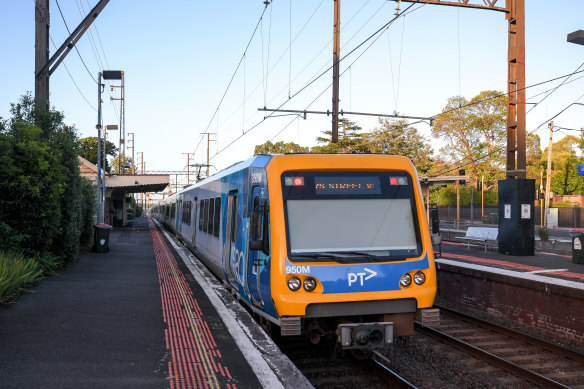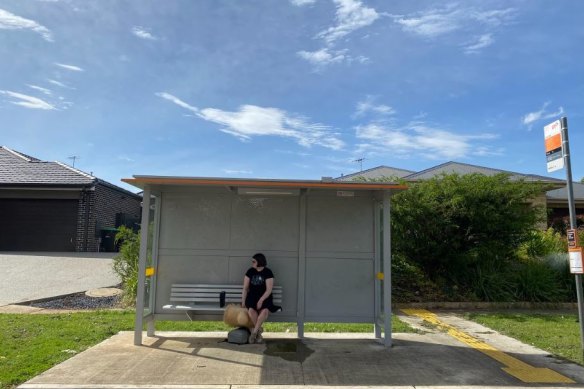This was published 8 months ago
Waiting on the weekend: Timetables haven’t moved with the post-pandemic times
Melbourne’s busiest public transport services have not kept up with population growth and post-pandemic travel patterns, according to a new analysis and advocates are pushing for investments to cut down on 30 and 40 minutes waits.
The analysis published by Peter Parker, a former Department of Transport bus planner, found population growth in housing estates with little public transport access had soared and that timetables had not adapted to a post-pandemic boom in weekend train patronage.

A train arrives at Mont Albert train station in 2022.Credit: Eddie Jim
The analysis, published on the Melbourne on Transit blog, estimated the number of kilometres for scheduled tram and train trips had gone backwards when measured against Melbourne’s soaring population growth.
It found that in 2014 there were five kilometres of metropolitan train services per person in Melbourne and 5.3 kilometres for the tram network. In 2023, this is estimated to have dropped to 4.8 and 4.7 kilometres respectively, with final figures on the number of scheduled kilometres to be confirmed in the May state budget.
“Had service just kept up with population, there’d be a lot fewer 30 to 40 minute waits as is currently common on the network even at popular times,” Parker said. “This would be a major advance for the small increment in service needed.”
Noting the overall drop in peak patronage due to increased working from home, Parker said a shift to weekend travel had not been met with the necessary additional services.
Parker also analysed a claim by Public Transport Minister Gabrielle Williams that Victoria had added 20,000 bus services and 2000 train services since Labor was elected in 2014.
He said this did not tell the full story because a single bus route running eight trips a day could theoretically add up 20,000 services over this period, and a better measure was how many additional services were running a day or a week.
He also said the Victorian Bus Plan was now 1000 days old and was yet to deliver the improvements needed for the network, which is vital in growing parts of the city.
An Allan government spokesman said more than 1200 metropolitan train services had been added to the network since 2015.

Bus travel from Melton is difficult.Credit: Rachael Dexter
“When reviewing public transport data to make decisions about the network, we use a range of inputs and consider a range of factors such as demand – not just a per capita approach,” he said.
Planning is also under way for a new timetable after the Metro Tunnel opens, which promises turn-up-and-go services on the Sunbury, Cranbourne and Pakenham lines.
LeadWest, an alliance of five councils in Melbourne’s west, is pushing for major improvements to bus services in the municipalities of Brimbank, Hobsons Bay, Maribyrnong, Melton and Wyndham.
LeadWest chair, and Melton councillor, Sophie Ramsey said some new suburbs in Brimbank, Melton and Wyndham had no services and this was worsening as more people moved to these areas.
“Rapid growth in Melbourne’s west has left communities without adequate bus services as bus route and service provision has not increased in line with population and job growth,” she said.
“Where there are bus services, peak frequency is about 30 minutes and travel time can often take close to twice as long as travelling by car. Buses need to run more often and later at night to match passenger demands. In some areas, such as parts of Maribyrnong, buses finish at 8pm.”
Ramsey said poor bus routes were discouraging people from reducing congestion by leaving the car at homes.
“In Melton for example, where there are bus services, frequency is poor and services are indirect, with travel time often close to twice that of travelling by car,” she said.
“The poor service is reflected in the fact that only 1 per cent of trips made in the City of Melton are by bus. All bus services within Melton Township have declined in patronage while the population of Melton has increased significantly between 2014 and 2019.”
Graham Currie, chair of public transport at Monash University, said car ownership was rising faster in Victoria than other states and public transport improvements were needed to reduce this reliance.
“We do have governments investing in new services, but the key question is whether it is enough,” he said.
“Public transport patronage is slowly recovering, but if the services aren’t keeping up with growth they will not be as effective as they should be for the future.”
Opposition public transport spokesman Matthew Guy said public transport services were not keeping pace with the state’s rapid growth.
“This issue will only become more acute as the Allan Labor Government puts every cent into the Suburban Rail Loop at the expense of public transport services across the state,” he said.
Start the day with a summary of the day’s most important and interesting stories, analysis and insights. Sign up for our Morning Edition newsletter.